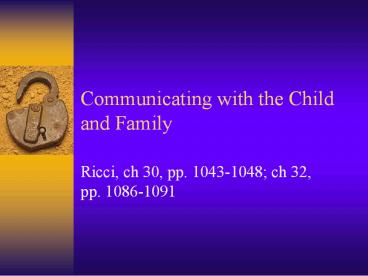Communicating with the Child and Family - PowerPoint PPT Presentation
1 / 22
Title: Communicating with the Child and Family
1
Communicating with the Child and Family
- Ricci, ch 30, pp. 1043-1048 ch 32, pp. 1086-1091
2
Understanding Pediatric Patients
- Hospitalization and illness are major stressors
because of the change in usual routines and a
childs limited coping mechanisms.
3
Reactions to Hospitalization
- Reactions are affected by
- Developmental age
- Previous experiences with illness
- Available support systems and coping abilities
- Seriousness of the illness
4
Stressors of Hospitalization
- Separation
- Loss of control
- Physical stressors, specifically fear of bodily
injury and pain
5
Risk Factors for Stressors
- Difficult temperament
- Lack of fit between child and parent or poor
parental support - Age (6 mos to 5 yrs)
- Males
- Below average intelligence
- Multiple and continuing stresses as in frequent
hospitalizations
6
Behaviors R/T Stressors
- Crying
- Clinging
- Fear/anxiety
- Refusal to eat
- Difficulty sleeping
- Anger
- Negativism, uncooperativeness
- Aggression, depression, regression
- Loneliness
- Boredom
- Withdrawal
7
Parental Responses
- Disbelief
- Anger
- Guilt
- Fear, anxiety
- Frustration
- Depression
8
Sibling Reactions
- Loneliness
- Fear
- Worry
- Anger
- Resentment
- Jealousy
- Guilt
9
Interventions to Minimize Stressors
- See Table 30.1
- Use play to provide diversion, increase security,
decrease anxiety, and allow expression of
feelings - Playrooms offer distancing
- Familiar toys are comforting
- Use large muscles, dramatic play, drawing,
puppets, books
10
Communicating with Children
- Make developmentally appropriate
- Rely on nonverbal behavior more than verbal
- Get on childs eye level but avoid staring at
child - Avoid sudden or rapid advances, broad smiles
- Always be truthful
- Give child choices as appropriate
- Allow children to express feelings and fears
- Offer praise, encouragement, and rewards
11
Communicating contd
- Avoid analogies and metaphors
- Give instructions clearly
- Give instructions in positive manner
- Use interpreter when needed
- Avoid long sentences, medical jargon,
colloquialisms think about scary words - (Table 30.2, p. 1042)
12
Creative Techniques
- I messages
- 3rd person
- Storytelling
- Bibliotherapy
- Dreams
- What if questions
- 3 wishes
- Rating (not just pain)
- Word association
- Sentence completion
- Pro and con list
- Writing and drawing
- Magic
- Play
13
Developmentally Appropriate CommunicationInfants
(0-12 mos)
- Non-verbal
- Crying as communication
- Pick up adults non-verbal behaviors
- If under 6 months, will usually respond to
anyone. - If over 6 months, stranger anxiety exists
14
Early Childhood (Toddler Preschool) 1-6 yrs
- Focus on CHILD in your communication
- Need warm-up time. May be uncooperative
- Use words child will recognize use short,
familiar, and concrete terms - Be consistent dont smile when doing painful
things - Allow child to handle most equipment
- Keep fearful equipment out of sight until it is
needed.
15
School Age (6-12 yrs)
- High level of curiosity likes to help
- Give explanations and reasons
- Explain how things work allow handling of most
equipment - Allow to express feelings
- Respect privacy
- Generally behave well and communicate effectively
16
Adolescent (12-18 yrs)
- Be honest with them
- Aware of privacy needs
- Think about developmental regression
- Importance of peers
- Listen to them and respect their views
- Avoid judging or criticizing tolerate
differences - Pick your battles
- Avoid the third degree
17
Play
- Childrens work
- Childs developmental workshop
- As therapeutic intervention
- As stress reliever for child/family
- As pain reliever/distracter
- As barometer of illness
18
Therapeutic Art
- Can tell about childs situation both from seeing
what he draws and what he says about it.
Important points - first figure
- size of figures
- order
- position
- exclusion
- accentuated parts
- absence of parts
- size and place of drawing
- stroke type
- erasures
- cross-hatching
19
Communicating with Parents
- Most information comes from them
- If parent sees a problem, pay attention
- Listen actively listen for information directed
over the childs head. - Try to be a facilitator in arriving at a solution
to the problem rather than always giving your
ideas - Remember to use open-ended questions that start
with what how tell me about
20
The Health History
- Pediatric health history has similar and
different components from adult history. - Past hx includes birth hx, immunizations, GD,
and habits in addition to the usual questions. - Review of systems is somewhat different than
adults especially in areas that require
evaluation of behavior (eyes or ears for
instance) and in sexual development.
21
Functional Assessment
- Determines childs daily routines
- Includes meals, activity, habits, sleep
behaviors, elimination routines, hygiene, day
care - Also determines health care issues including
routine visits to doctors and dentists, use of
assistive devices, sexual practices, sun
exposure, piercings, tattoos. - Also includes cultural/religious practices, for
instance, cupping and coining.
22
Complete Family Assessment
- Family composition
- Home environment
- Occupation and education of members
- Cultural and religious elements
- Family interactions including who makes
decisions, how members communicate, how they
solve problems, disciplinary methods, and support
for each other

